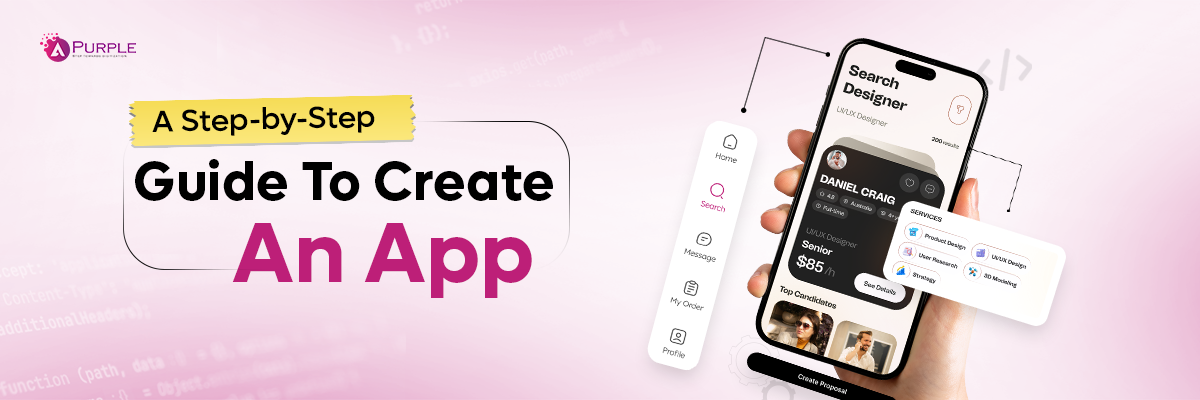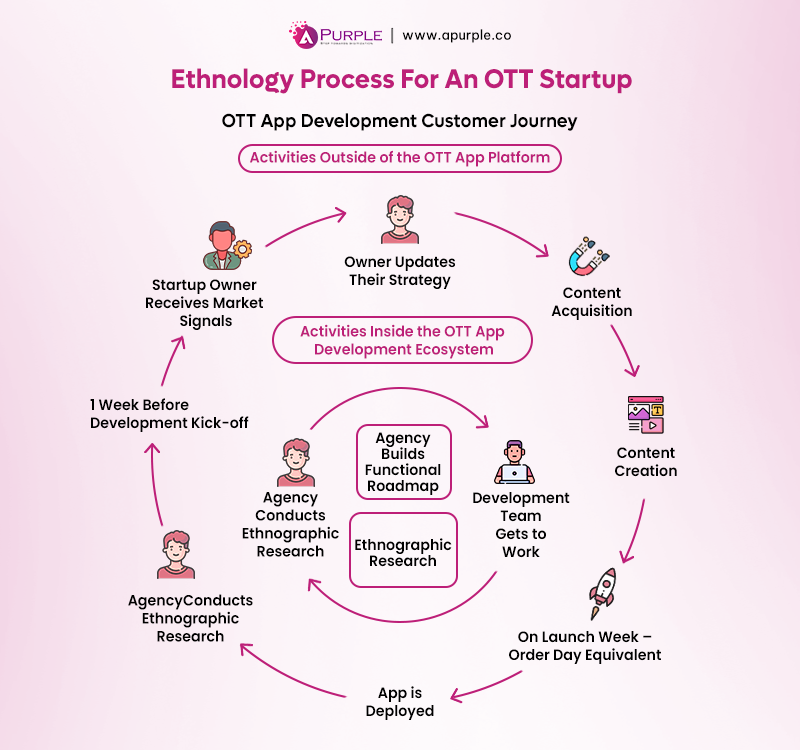Building a startup requires two essential things: a powerful app idea and flawless execution. As an entrepreneur, getting both right is no small feat. It demands a deep understanding of your users, a scalable tech plan, and more strategy than guesswork.
Without a clear process, you risk investing time and money in an app that no one needs.
So, how to create an app that not only works but wins in the market?
And more importantly, how do you ensure your idea has product–market fit before you build it?
This guide breaks down every step founders must follow from validating their idea to launching the app with confidence. Let’s get started.
How to Create An App For Your Startup?
Creating an app requires a step-by-step process that includes everything from ideation to design, development, and deployment.
Here is a comprehensive how to create an app step-by-step guide for your startup.
- Define Your Idea And Target Audience
- Conduct Thorough Research And Plan Your App
- Plan Features And Design UX
- Choose Your Development Approach
- Estimate Cost And Finalize Tech Stack
- Build Your MVP
- Testing Your App
- Gather User Feedback
- Craft A Pre-Launch Marketing Strategy
- Make The Most Of Your Launch Day
1. Define Your Idea And Target Audience
Defining the idea is the key step that sets the base for the entire process. As an entrepreneur looking to build a startup from scratch, validating the concept is crucial before investing heavily in it. So the answer to how to make an app for your business lies in questions such as,
- What is the purpose of your app?
- What problems will it solve?
- Who is the app aimed at?
- Why would someone be interested in your app?
- What are the specific goals for creating an app?
Pro Tip-
Create a one-sentence idea value proposition and share it with an industry peer with no idea of what you are building. If the person does not get your idea, refine it for clarity.
2. Conduct Thorough Research And Plan Your App
Researching your target market and planning the entire app creation is crucial while preparing for how to create an app. It enables you to find the product-market fit, understand market needs, choose the business model type, and allocate a budget for app development.
Here are some questions to consider while researching and planning the app creation,
- What is your target market?
- What is the size of the potential user base?
- What platforms do they use most (iOS, Android, web)?
- Who are your main competitors?
- What are their strengths and weaknesses?
- How will your app generate revenue?
- How to create an app from scratch?
- How hard is it to create an app?
- Do you possess the necessary resources and skills to create an app?
Pro Tip-
Create detailed user personas before you start development. This helps you visualize your target audience and tailor your app’s features to real user needs. Consult with startup experts to ensure you make more informed decisions throughout the planning and design stages.
3. Plan Features And Design UX
A crucial part of your app creation process is to decide what features to add and designing the user experience. As a startup owner or entrepreneur struggling to develop an app for your business, focusing on the user journey can be helpful. It will enable you to understand how users will interact with your app and identify design gaps and features that will solve their problems.
Identifying features can be a complex task for any entrepreneur. Because you need to be specific about what features will solve the user’s problems and what are secondary ones. You can leverage the “Ethnography” approach.
Ethnography is a qualitative research approach that startups can use to conduct an in-depth study of their target audience. It allows entrepreneurs to understand the cultures to which their audience belongs through direct observation and participation.
For example, if you plan to create an OTT app you can recruit participants who represent your target audience. Ask them to self-record their experiences, thoughts, and feelings while you provide access to the minimum viable product (MVP) version.
Provide users with specific activities, such as searching for a movie, setting up a profile, or watching a series, and have them document their process, including any frustrations they encounter. Based on this data, you can identify gaps in user experience, design your app, and add features accordingly.
Create wireframes and prototypes using tools like Figma or Sketch to map out the app’s structure and flow. Prioritize clarity, accessibility, and intuitive navigation, drawing inspiration from proven UI design patterns such as bento grids for content organization.
Pro Tip-
Collect and organize all media and notes received from participants in a dashboard, utilizing AI tools to identify patterns, pain points, and opportunities for improvement.
4. Choose Your Development Approach
Another crucial aspect of how to make app for your startup is deciding on the development approach you will take. It helps you plan the entire development process. Here is a four-step method to determine the best development approach for your startup.
1. Know what you need the app for
Ask the following questions to identify your app’s true purpose first,
- What’s the real problem at hand?
- What are the core features of the app?
- How long does it take to create an app?
- How much is it to create an app
2. Analyze different approaches
Here are the approaches you can choose while preparing for how to create an app.
- Native application development involves creating separate applications for Android and iOS. You need to determine the platform.
- Cross-platform development allows you to create apps that work across platforms using the same codebase.
- Web app development is an approach where your application runs on a browser but offers the same performance as native apps.
- Hybrid app development combines both native and cross-platform development approaches, where apps built with web technologies are deployed within a native container.
3. Consider technical aspects
Choosing the development approach also needs consideration of technical aspects like,
- Programming languages and frameworks that align with the development approach
- Compatibility across OS and devices for your app
- Check for backend scalability to handle increased traffic
- Consider the APIs you will need and their compatibility.
4. Decide which approach to use
Here is how you can decide the development approach based on purpose, technical aspects, and other aspects.
- If you require high-performance apps with complex features that can leverage native APIs, opt for the native development approach.
- If you need faster and cost-effective app creation for your startup, choose a cross-platform development approach.
- If you need a quick and accessible app for a broad audience, a web app development approach is a sensible choice.
- Hybrid development is best if you need the best of both a cross-platform and a native approach.
Pro Tip-
Leverage AI-assisted development services if you want more pace compared to traditional development approaches. It allows you to quickly create a startup app and reduce the time to market.
Now that you’ve chosen your development approach, it’s time to estimate the cost and finalize your tech stack.
5. Estimate Cost And Finalize Tech Stack
As a startup founder, budgeting smartly and selecting the right technologies early on helps avoid costly pivots later. The cost depends on multiple factors, including features, platforms, backend complexity, design, and developer rates. Partnering with an experienced mobile app development company can help you plan modular budgets and avoid scope creep.
Here is a breakdown of app development costs, categorized by app complexity.
| Complexity | Approach | Cost |
|---|---|---|
| Basic App | Traditional | $10,000 – $25,000 |
| AI-Assisted | $20,000 – $40,000 | |
| Medium App | Traditional | $25,000 – $60,000 |
| AI-Assisted | $40,000 – $80,000 | |
| Complex App | Traditional | $60,000 – $85,000 |
| AI-Assisted | $80,000 – $150,000+ |
Pro Tip-
Consult an expert app development company to select a battle-tested tech stack that matches your app’s scope and speed-to-market goals.
6. Build Your MVP
Build an MVP by implementing only the core features that solve your users’ primary problems. This approach enables you to launch quickly, validate your idea, and gather user feedback without incurring significant costs. You can leverage customized solutions from an MVP app development company for idea validations and quicker time to market.
Such companies can help you adopt an agile approach to continuously improve your app through iterative development. Agile app development also allows you to integrate customer feedback instantly, ensuring a user-centric application for your startup.
Pro Tip-
Set clear success metrics for your MVP (e.g., user retention, engagement rates) to measure whether your app is meeting its goals. You can hire developers from an experienced app development company to build fast, test faster, and iterate smarter without breaking your budget.
Once your MVP is ready, the next crucial step is to rigorously test your app and collect actionable feedback. This phase of preparation for creating an app for your business ensures that your app meets customer expectations.
7. Testing Your App
Testing is more than just finding bugs- it’s about ensuring quality and a seamless user experience. As a startup founder, you should focus on multiple types of testing:
- Functional Testing- Does every feature work as expected?
- Usability Testing- Is the app intuitive and easy to navigate?
- Performance Testing- Does the app load quickly and handle expected user traffic?
- Compatibility Testing- Does your app work smoothly across different devices, operating systems, and screen sizes?
- Security Testing- Are user data and transactions protected?
Pro Tip-
Recruit a small group of real users (outside your development team) to test the app in real-world scenarios. Encourage them to perform everyday tasks and report any issues or confusion they encounter.
8. Gather User Feedback
After initial testing, it’s time to collect feedback from your early adopters. This feedback is invaluable for refining your app and ensuring it meets the needs of users.
Ask questions such as:
- What do users like most about the app?
- What features are missing or confusing?
- Are there any recurring bugs or crashes?
- How does the app compare to competitors?
Pro Tip-
Create a feedback loop by responding to user suggestions and letting them know how their input is shaping future updates. This builds trust and encourages continued engagement.
Ensuring your app reaches your target audience is essential. A well-planned marketing strategy can make all the difference between a launch that goes unnoticed and one that is successful.
9. Craft a Pre-Launch Marketing Strategy
Start building anticipation before your app goes live. This helps you gather early interest and ensures you have an audience ready to download on launch day.
- Design a simple and informative website that effectively highlights your app’s value proposition, key features, and launch date. Include an email signup form to capture leads.
- Share sneak peeks, behind-the-scenes content, and countdowns on platforms where your target audience spends time.
- Participate in relevant forums, groups, and online communities to stay informed and engaged. Share your journey and invite feedback or beta testers.
Pro Tip-
Offer exclusive early access or incentives (like premium features or discounts) to users who sign up before launch. This can help you build a loyal user base from the very beginning.
10. Make The Most Of Your Launch Day
Once you have passed the stage of creating an app, it’s time to deploy it on app stores and gain momentum in the market on that launch day. Submit the apps and create a strategy to maximize visibility during the launch event.
Maximize visibility and downloads with these strategies:
- Press Release- Distribute a press release to tech blogs, startup news sites, and industry publications.
- App Store Optimization (ASO)- Use relevant keywords, compelling descriptions, and high-quality screenshots to improve your app’s visibility in app stores.
- Influencer Outreach- Partner with influencers or micro-influencers in your niche to review or mention your app.
- Email Marketing- Send launch announcements to your pre-launch email list, highlighting key features and including download links.
Pro Tip-
Prepare a media kit with your app’s logo, screenshots, and a concise description. This makes it easy for journalists and bloggers to cover your launch.
Final Thoughts
Validating the idea quickly and creating an app both become a challenge if you don’t plan well. From choosing the right business model to identifying the target audience, features, and platforms to deploy the apps, there are many aspects that you need to consider.
While planning is essential, the execution of startup app development is a complex process. So, you need a trusted partner that can help you not only strategically plan the app development but also ensure continuous improvements. aPurple is a leading startup app development agency that can help you with custom solutions.
With more than 800 successful startup apps delivered across industries, we can help you create applications that meet the expectations of your target audience. If you’re still wondering how to create an app from scratch or have an idea you’d like to execute, contact us now.
FAQs






